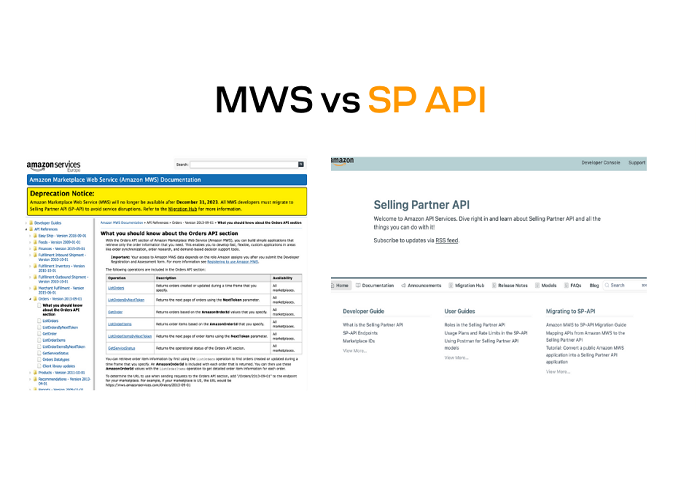
Amazon SP API V/S MWS: Which One Should You Choose?
The new Amazon Selling Partner API, amazon SP API was announced not too long ago. All companies and sellers serious about their market presence should jump at the chance to use this new API, which will replace the antiquated MWS. Let’s examine the benefits of this significant improvement and the upcoming adjustments.
For more than a decade, MWS has been the go-to interface for managing all aspects of your Amazon store, from shipping products and handling orders and stock to automatic pricing adjustments and more. It’s a powerful instrument, but it needed some polishing: this XML API was a design that fell out of favor as JSON-based APIs became more widespread. Error handling takes a long time, there is a cap on throughput, and things move slowly.
What is “Amazon MWS?
All sizes of Amazon sellers can take advantage of the Amazon Marketplace Web Service (Amazon MWS), an application programming interface. For more than a decade, MWS APIs have provided Amazon merchants with easy, programmatic access to a wide variety of Amazon services. With Amazon MWS, retailers can streamline order processing and boost productivity by integrating data from their Amazon stores.
What is a Selling Partner Application Programming Interface (SP-API)?
There is an improved version of Amazon MWS, API for amazon products called the Selling Partner API (SP-API). It has the same functionality as Amazon MWS, however any future updates will be made through the SP-API. Consequently, SP-API is the next generation of APIs built on top of the APIs provided by Amazon’s Marketplace Web Service (MWS).
- The SP-API is a far more advanced variant of Amazon’s MWS. Here are a few of the latest additions to the SP-API:
- Newfangled REST APIs supporting JSON input and output
- There are now brand-new service endpoints available in every location.
- A sandbox environment where fake data can be used to test against many sandbox APIs. This means that the sandbox can now be used for testing purposes.
- The ability to develop a software development kit that facilitates LWA token trading and authentication.
- Bid limits for each sales partner are dynamically adjusted based on usage data.
- API for Amazon Vendors is a brand new addition to SP-API, and it uses the same control plane and authentication methods as the rest of the API.
- Support for RDTs (Restricted Data Tokens) to provide a safe method of accessing personally identifiable information (PII) from customers.
- Rate caps are dynamically adjusted for each sales partner under a dynamic usage plan based on a number of parameters.
More about (SP-API)
The Selling Partner API (SP-API) replaces the older API Amazon MWS with a more up-to-date version that adheres to modern developer expectations and makes migration as painless as possible. There are a dozen new APIs available for Vendor Central, and this new API is live with all the functionality from MWS.
Features of SP-API
- API call limits that adjust dynamically over time to meet the changing demands of individual merchants.
- Streamlining authentication and permissions management: Login with Amazon (LWA) is Amazon’s OAuth 2.0 implementation, and it’s used for authentication.
- The most-requested feature in MWS is a development environment where users may experiment with APIs before deploying them.
- The initial application programming interface for Vendor Central (wherein you bypass traditional distributors in favor of Amazon itself).
- To further automate data flow, increase sales efficiency, streamline manual procedures, gain access to Insights and forecasts regarding consumer purchase intent, optimize advertising costs, etc., SP-API is also implemented.
What I have to do?
Don’t freak out! All shops that support Amazon’s MWS have access to SP-API, so the switch won’t happen suddenly. In the future, all enhancements will be incorporated into SP-API, with MWS upgrades reserved for absolutely necessary alterations to vendors’ operations.
Therefore, you are under no immediate need to make the switch to SP-API. However, we strongly suggest that you evaluate your current integration in preparation for planning your switch. More than anyone else, Amazon sellers have realized that data integration results in sophisticated automation of sales and facilitates rapid expansion of an online store.
Consequently, Amazon Sellers employ a technology known as “API” (Application Programming Interface) to automate data flow and improve administration of inventory and sales processes. An application programming interface (API) is a piece of software that facilitates communication and collaboration between separate software applications. The application programming interface (API) manages the processing and flow of data across several systems.
Final Words
Amazon claims that in the future, any new API features will be incorporated into the Amazon Selling API, and that MWS updates will only be carried out to support certain mission-critical alterations. To succeed on Amazon, merchants must use every available strategy. Those who sell the most on Amazon are the most successful because they know how to put statistics to work for them. In the past, they relied on a defunct set of data APIs known as Amazon Merchant Services (MWS) to automate routine business tasks.
Selling on Amazon is where it’s at in the future. Direct, automated access to SP-API data helps retailers learn when customers are most likely to make purchases, which in turn improves ad spend efficiency, inventory management, promotion targeting, and more.




